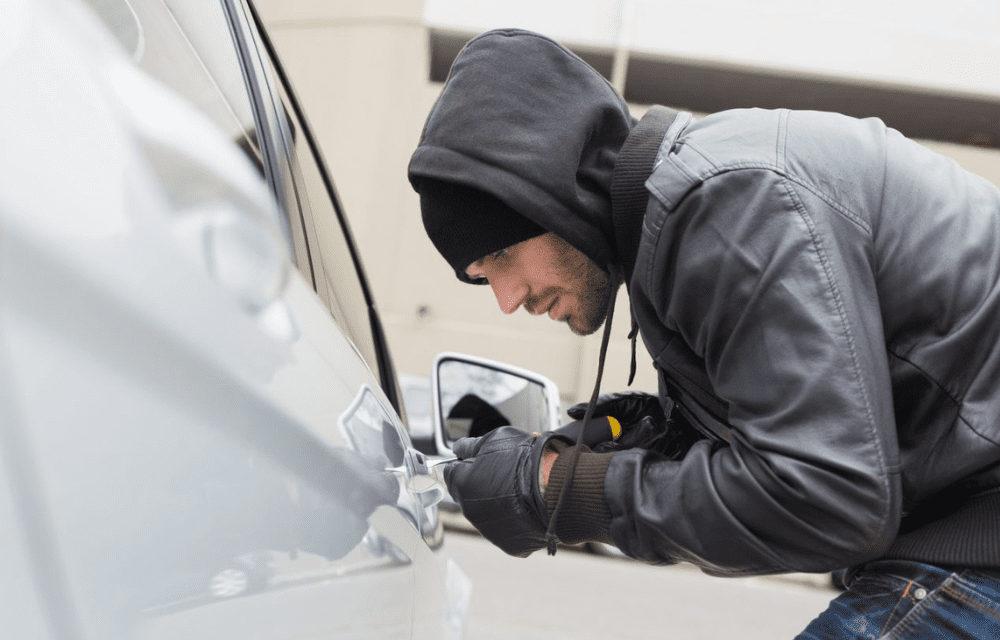
What Does Car Insurance Cover in the Case of Theft?
TABLE OF CONTENTS
Comprehensive coverage (a component of most car insurance policies) pays to cover the theft of a car. Unfortunately, comprehensive insurance will not reimburse you for any personal items that may have been inside that stolen vehicle. But there are other types of insurance, explained below, that help you recover more from the loss of your car and the items that were in it.
KEY TAKEAWAYS
- 1
Comprehensive coverage is an essential component of most car insurance policies that can help pay for damages incurred in the event of car theft, but it does not cover personal items inside the vehicle.
- 2
Replacement value, which is the amount paid out by the insurer in the event of a car theft claim, is typically lower than the original purchase price of the car and factors like age, mileage, make and model, and condition of the car play a role in that.
- 3
It's important to know the exclusions and any waiting period in your car insurance policy, and consider adding gap insurance to cover any shortfall in case of car theft.
How does insurance cover car theft?
Celebrity chef Guy Fieri probably asked this very question back in 2011. That’s when a 16-year-old rappelled into a car dealership and stole Fieri’s yellow Lamborghini.1 Presumably, Fieri had full coverage on his Lambo and filed a claim with his insurer.
Full coverage in the auto insurance world usually means a combination of liability insurance, uninsured motorist protection, personal injury protection or medical payments coverage, collision coverage, and comprehensive coverage.2 These all provide different forms of protection, but it’s the comprehensive coverage that comes into play when your vehicle is stolen. While not having comprehensive is one of a few ways to save on insurance, we don’t recommend skipping it. It is one of the cheapest coverages on a typical policy, far cheaper than collision coverage.
Comprehensive insurance
Comprehensive insurance helps pay for car damage that didn’t result from a collision. Theft is in that category, as well as damage from vandalism, fire, natural disasters, or falling tree branches. In non-theft situations, you’d file a claim for the damages and the insurer would pay for necessary repairs, less your deductible. When someone steals your car, the “damages” equal the replacement value of your car, also known as actual cash value or ACV.
Replacement value, unfortunately, does not equal what you paid for the car. The car today naturally has less value than the day you bought it. And so, the replacement value will be lower. Not only that, but you have to pay your deductible on this claim, too.
Also, most insurers do impose a waiting period before they’ll pay the claim on a stolen car. It’s typically 30 days from the date the car disappeared.3 Ask your insurance adjuster for the specifics of your policy.
How gap insurance may help
If you financed your car, the replacement value paid out by your insurer may be less than what you owe on your car loan. It’s easy to see why you’d want to avoid this scenario. Your car gets stolen, your insurance company pays the claim, and then you still have to pay more, out-of-pocket, to close out the loan. This tends to happen when:
you bought the car with a very small down payment,
your loan term is very long, like 60 months or more,
the make and model you purchased don’t hold its resale value well, or
you drive a lot and the added miles reduce your car’s value quickly.
Gap insurance is an affordable way to avoid this outcome; it will cover the shortfall between the car’s replacement value and your loan balance. If you add gap insurance to an existing policy, it usually costs about $20 a year. Some dealerships and auto lenders may try to sell you more expensive gap insurance for a flat fee, and that can cost $500 or more.4
Will car insurance cover: 5 car theft scenarios
Sadly, thieves are not one-trick ponies. One bad guy might drive away in your car, and another might simply break in and take the laptop that’s sitting on the passenger seat. These are very different scenarios for your insurance carrier to address. Here’s a look at five theft-related situations, and how your insurance provider will handle them.
1. You left the keys in the car.
Never leave your keys in the car. It makes the car an easy target for thieves, it could cause your insurer to deny your claim, and it may be a violation of state law. Read the fine print of your policy; you’re looking for exclusions on your comprehensive coverage and language on negligent theft. If you live in Texas, you’ll definitely have trouble getting an insurer to pay your claim — it’s actually illegal in your state to leave your car unattended with the keys inside.5
Even if the insurer does pay out the replacement cost, you’re likely to see your rates increase. Your carrier may even cancel your coverage after the fact.
2. Your car was broken into and damaged, but not stolen.
Thieves aren’t known for being tidy or subtle. Unless you left the doors unlocked, a car break-in usually leaves a mess behind: broken windshield or window, a picked lock, or a pried-open trunk lid. Comprehensive coverage will pay for this damage, less your deductible. Take care to document everything unusual with photos and file a police report to increase the strength of your claim.
3. Someone broke into your car and stole your wallet.
Your car insurance will cover your car, but not theft of your personal items — even if someone steals them during a vehicle break-in. You have another option, though. Your homeowner's or renter’s insurance policy should cover the stuff nabbed from your car.
You could file one claim with your auto insurer for the damage to your car, and a separate claim with your homeowners or renters carrier to get reimbursed for your things. Of course, if your homeowner's or renters' policy has a high deductible, this strategy only makes sense if the thief walked away with high-value items.
4. Your car was stolen and recovered later.
Nationwide, nearly 60% of all stolen vehicles are eventually recovered.6 If your car is found before the claim is paid and has only minor damage, your comprehensive coverage would pay for the necessary repairs, less your deductible. If you find your car after you’ve paid out the replacement value, then your insurer assumes ownership of the car. You may have the option to buy the car back from the insurance company at a low price.
5. Your stolen car had pricey aftermarket upgrades.
The replacement value of your stolen car won’t reflect your aftermarket upgrades unless you have extra coverage specifically for those parts. The same idea applies if a thief leaves the car in place, but walks off with your aftermarket wheels and tires. Your comprehensive insurance will pay for new factory wheels and tires only.
Steps to protect against car thieves and vandals
You never come out ahead when someone steals your car. At a minimum, you’ll pay out your comprehensive deductible. In the worst-case scenario, you’ll fund the deductible, reach into your pocket to pay off your car loan, and also have to replace the MacBook, iPhone, and TomTom that were in the car. It’s smart to hedge against those outcomes. Particularly so when driving a model commonly targeted by thieves.
Here’s a list of the 10-most stolen vehicles, according to National Insurance Crime Bureau (NICB)7
Honda Civic
Honda Accord
Full-size Ford Pickup
Full-size Chevrolet Pickup
Toyota Camry
Nissan Altima
Toyota Corolla
Full-size GMC Pickup
Full-size Dodge Ram Pickup
Jeep Cherokee or Grand Cherokee
The gist is, if you drive a Honda or Toyota sedan, a full-size pickup, or a Jeep Cherokee, you’re already at higher risk of having your car stolen. Protect yourself by following these seven best practices.
How to help hamper car heists:
Always lock your doors.
Always remove the keys from the car. According to the National Insurance Crime Bureau, nearly 82,000 vehicles were stolen in 2018 with the keys left inside.8
Conceal all valuables. Don’t leave briefcases, wallets, purses, or phones sitting on the front seat.
Use The Club, which locks your steering wheel.
Use wheel locks, which keep your wheels in place. A thief who’s going to sell the parts of your car would prefer not to meddle with wheel locks.
Have someone etch your VIN into the windshield. A car with the VIN etched in the windshield is a less attractive target for thieves.9
Park in well-lit spots.
What to do when your car is stolen
Before someone drives off with your car, organize your ownership documents. Have the VIN, plus proof of registration and insurance on hand. That’ll make things easier if you do have to file a stolen vehicle claim.
Once you realize your car has been lifted, call the police and file a report. Keep the report number on hand. Then, notify your insurance carrier and your auto lender within 24 hours. Expect some back and forth with your claims adjuster. Do your best to be available and answer all questions quickly. If financed, keep making your payments until the claim is resolved. Your gap insurance won’t cover late payments on your loan.
Chances are, you don’t drive a yellow Lambo — but that doesn’t mean your car isn’t important to you, or that you don’t need to get that replacement value payout, fast. To move the process forward, get organized, and respond to all queries from the police, your insurance carrier, and your auto lender.
- Pera, M. (2019, December 20). Guy Fieri Lamborghini theft: Notorious convict Max Wade seeks lighter sentence. Retrieved April 22, 2020 from https://www.mercurynews.com/2019/12/20/marin-lamborghini-thief-max-wade-seeks-lighter-sentence/
- Megna, M. (2017, March 13). Full coverage car insurance explained. Retrieved April 22, 2020 from https://www.insurance.com/auto-insurance/coverage/full-coverage.html
- Holloway, C. (n.d.). Car Insurance for a Stolen Car. Retrieved April 22, 2020 from https://accident-law.freeadvice.com/accident-law/auto/car-insurance-stolen-car.htm
- What’s UP with Gap Insurance? (2016, March 11). Retrieved April 22, 2020 from https://www.uphelp.org/pubs/what’s-gap-insurance
- Texas Transportation Code § 545.404. (n.d.). Retrieved April 22, 2020 from https://codes.findlaw.com/tx/transportation-code/transp-sect-545-404.html
- Arevalo, T. (n.d.). Most Essential Car Theft Statistics, Facts & Trends for 2020. Retrieved April 22, 2020 from https://carsurance.net/blog/car-theft-statistics/
- NICB’s Hot Wheels: America’s 10 Most Stolen Vehicles (2018 Data). (n.d.). Retrieved April 22, 2020 from https://www.nicb.org/news/news-releases/nicbs-hot-wheels-americas-10-most-stolen-vehicles-2018-data
- Warning, Warming-Up Your Vehicle Could Cost You. (n.d.). Retrieved April 22, 2020 from https://www.nicb.org/news/news-releases/warning-warming-your-vehicle-could-cost-you
- VIN Etching Fact Sheet. (n.d.). Retrieved April 22, 2020 from https://www.allstate.com/resources/allstate/attachments/tools-and-resources/vin-etching-fact-sheet.pdf
TABLE OF CONTENTS


Trying to find the best insurance?
We'll help you find the policy that offers the best value for your situation.
Further Reading

Navigating the Digital Insurance Landscape Considerations
A look at the immense value and high customer lifetime potential within the insurance sector.
Read article

When is Term Life Insurance Worth it?
Decide if term life's advantages are worth it: compare whole vs term life insurance, assess top term providers, and delve into in-depth reviews.
Read article

Insurance Binder: Bridging Between Coverage and Confirmation
From car loans to rental properties, insurance binders are required in a variety of situations. Discover the ins and outs of these essential documents.
Read article

Haven Life Review: Providing Prudent and Protective Policies
Uncover the benefits and drawbacks of Haven Life's term insurance policies, along with eligibility details, pricing, and customer feedback..
Read article
Start Comparing Quotes
Search from our learning center to learn everything from how to easily switch your car insurance to the ins and outs of home insurance.
Fill out just one form and get multiple quotes!




